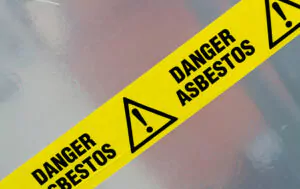Asbestos Exposure at Workplaces: Health Risks, Causes & Preventive Measures
Asbestos exposure in the workplace is a significant concern, particularly in industries where older buildings and materials are prevalent.
Asbestos was once widely used for its durability and heat-resistant properties, making it a common component in construction and industrial applications. However, it’s now known that exposure to asbestos fibres can lead to severe health issues, including respiratory diseases and cancer.
Workers in construction, maintenance, and manufacturing industries are particularly at risk, especially working with buildings or products made before 2000. The dangers of asbestos exposure are not always immediately apparent, as the effects can take years, even decades, to manifest.
Understanding the dangers of asbestos exposure and how to manage them effectively are essential for protecting the health of workers. This is where asbestos awareness training becomes vital.
For those working in environments where asbestos might be present, completing Asbestos Awareness training, such as the UKATA Asbestos Awareness online course offered by 3B, is a key preventive measure.
This eLearning course provides all of the information and practical guidance to help workers stay safe and ensure workplaces comply with health and safety regulations.
What is Asbestos?
Asbestos is a naturally occurring mineral composed of flexible fibres that are resistant to heat, electricity, and corrosion. Due to these properties, asbestos was widely used throughout the 20th century in various industries, particularly in construction.
It was commonly found in materials such as insulation, roofing shingles, floor tiles, and cement products. The fibres of asbestos are microscopic, making them easy to inhale when they become airborne. This often happens when asbestos-containing materials are disturbed or damaged.
While asbestos was prized for its durability and versatility, it was later discovered to be a significant health hazard. When asbestos fibres are inhaled, they can become trapped in the respiratory system, leading to serious health issues over time.
This includes long-term damage, like lung diseases and cancers that may not develop until many years after exposure. This delayed impact is what makes asbestos dangerous, as individuals may be unaware of exposure until it is too late.
How Does Asbestos Exposure Occur?
Asbestos exposure typically occurs in workplace scenarios where asbestos-containing materials (ACMs) are disturbed, causing the fibres to become airborne. Asbestos exposure is common in construction projects, where old buildings containing asbestos materials are being renovated or demolished.
Workers who carry out tasks such as cutting, drilling, or sanding asbestos-containing materials are at a heightened risk, as these actions can easily release fibres into the air. Maintenance work in older structures can also pose a risk, especially if insulation or other materials containing asbestos are damaged.
Asbestos fibres can easily be inhaled once they are released into the air. Inhalation of these fibres is the primary way asbestos exposure occurs. The risks increase significantly in enclosed spaces where asbestos dust can accumulate.
Health Risks Associated with Asbestos Exposure
The health risks associated with asbestos exposure are severe and can be life-threatening. One of the most common conditions caused by asbestos exposure is asbestosis, a chronic lung disease.
Asbestosis leads to lung tissue scarring, which causes shortness of breath and increases the risk of other serious lung conditions.
Another major health risk is lung cancer, which is strongly linked to asbestos exposure. The risk of developing lung cancer is significantly higher for individuals who have been exposed to asbestos.
The most serious health condition related to asbestos exposure is mesothelioma, a rare but aggressive form of cancer that affects the lining of the lungs, heart, or abdomen. Mesothelioma has a poor prognosis, and it is almost exclusively caused by asbestos exposure. These conditions often develop many years after the initial exposure. This is why preventing asbestos exposure is critical to protecting long-term health.
Causes of Asbestos Exposure in the Workplace
Some of the most common sources of asbestos in the workplace include:
- insulation materials
- roofing shingles
- floor tiles
- cement products
As these materials age or become damaged, they can release asbestos fibres into the air, increasing the risk of exposure.
As well as building materials, asbestos was also used in machinery and equipment, particularly in products that required heat resistance, like brake linings and gaskets. Workers who repair or maintain older machinery may also be at risk of exposure.
Industries at High Risk of Asbestos Exposure
Several industries are particularly at risk of asbestos exposure due to the nature of their work. The construction industry is one of the most affected, as workers frequently encounter asbestos-containing materials during the renovation, demolition, or maintenance of older buildings.
Shipbuilding is another industry where asbestos was heavily used, particularly in insulation and fireproofing materials. Workers involved in the repair and maintenance of ships are at risk of exposure, especially in older vessels.
Manufacturing is another industry where asbestos exposure remains a concern. In the past, asbestos was used in the production of a wide range of goods, from automotive parts to textiles. Workers who handled raw asbestos or asbestos-containing products were at significant risk of exposure.
While the use of asbestos has since been banned or restricted, those working with older machinery or in facilities that once used asbestos products may still face exposure risks.
Asbestos Exposure: Legal and Regulatory Obligations
Management and regulations surrounding asbestos have changed over the years due to increased awareness of the health risks. However, these regulations were not always in place, and many buildings constructed before the year 2000 may still contain asbestos.
The legal obligations for managing asbestos are clear: employers are required to protect workers from asbestos exposure by identifying and managing asbestos-containing materials.
The Control of Asbestos Regulations, which govern the management of asbestos in the UK, mandate that employers must conduct risk assessments, maintain an asbestos register, and ensure that any work involving asbestos is carried out by trained and competent individuals.
Failure to comply with these regulations can result in significant legal penalties and, more importantly, put workers’ health at serious risk. Despite these regulations, non-compliance or lack of awareness can lead to ongoing exposure risks, particularly in industries where asbestos was once widely used.
Ensuring compliance with these regulations through proper training and management is essential for preventing asbestos exposure in the workplace.
Importance of Asbestos Awareness Training
Asbestos Awareness training plays a critical role in preventing exposure to this hazardous material. Proper training equips workers with the knowledge they need to identify asbestos-containing materials (ACMs) and understand the significant health risks associated with exposure.
By learning to recognise these dangers, workers can take the appropriate steps to avoid disturbing asbestos and releasing its fibres into the air, where they can be inhaled. Additionally, asbestos awareness training provides essential guidance on the correct safety procedures to follow if asbestos is suspected. This minimises the risk of exposure not only for the individual worker but for everyone in the surrounding environment.
For those working in industries where asbestos might be present, such as construction, maintenance, or refurbishment, completing a comprehensive training program is not just a precaution—it’s a necessity. The UKATA Asbestos Awareness online course offered from 3B Training is an essential resource for these workers.
This course covers the necessary aspects of asbestos awareness, from identifying ACMs to the steps to take to ensure safety. By completing this Asbestos course online, workers can confidently handle situations where asbestos might be a concern, significantly reducing the risk of harmful exposure.
UKATA Asbestos Awareness eLearning Course Content and Structure
The UKATA asbestos awareness online course provided by 3B Training is designed to give learners a comprehensive understanding of asbestos and how to manage its risks effectively. The course is structured into several key modules, each focusing on different aspects of asbestos awareness:
Properties, Risks and Health Effects of Asbestos
This module covers what asbestos is, its physical properties, and the risks associated with asbestos exposure.
Asbestos General Knowledge
This module provides general knowledge of asbestos, e.g. different types, why it was used and where it is typically found.
Identifying ACMs and Avoiding the Risk
This section teaches learners how to recognise asbestos-containing materials (ACMs) in the workplace and the conditions that might increase the risk of exposure. It also looks at asbestos registers and emergency procedures.
Asbestos-Related Legislation
The course also covers the relevant laws and regulations governing asbestos management in the workplace, ensuring that learners understand their legal responsibilities and the importance of compliance.
Course exam
Once you have finished the learning, there is an end of course exam to complete. In the exam, you will have 40 minutes to answer 15 multiple-choice questions. In order to pass the course and receive a certificate, you will need to answer 12 questions correctly.
Benefits of Taking the eLearning Course Online
Taking the Asbestos Awareness course online offers several advantages, particularly in terms of flexibility and accessibility. Learners can complete the course at their own pace and fit their training around their work and other commitments.
This is especially beneficial for busy workers who may not have the time to attend in-person training sessions.
The eLearning format also makes the course accessible from anywhere with an internet connection, so learners can complete the course from the comfort of their own home or office.
The course includes interactive elements such as video lessons, quizzes, and a final asbestos test online, which help to reinforce learning and ensure that learners thoroughly understand the material. This interactive approach not only makes the course more engaging but also helps learners to retain the information better.
Certification and Compliance
Upon successfully completing the UKATA asbestos awareness online course, learners receive a UKATA-accredited certificate. This certification is valid for 12 months and is a critical document for demonstrating compliance with health and safety regulations.
Holding a UKATA certificate shows that the learner has received the appropriate training and is aware of the risks associated with asbestos, as well as the necessary precautions to take in order to avoid exposure.
For employers, ensuring that all relevant workers hold a valid asbestos awareness certificate is a key part of meeting legal obligations and maintaining a safe workplace. The certification process is straightforward, and renewing the certificate annually ensures that workers stay up-to-date with the latest asbestos safety practices and regulations.
By obtaining and maintaining UKATA certification, both workers and employers can be confident that they are doing everything possible to prevent asbestos exposure and protect health and safety on the job.
Asbestos Exposure and Awareness Training FAQs
What is asbestos exposure?
Asbestos exposure occurs when asbestos fibres are released into the air and then inhaled. These fibres can become lodged in the respiratory system, potentially leading to serious health conditions over time.
Who is at risk of asbestos exposure?
Individuals who work in environments where asbestos-containing materials (ACMs) may be present are particularly at risk of asbestos exposure. This includes workers in construction, demolition, maintenance, and manufacturing industries, especially those who work in or around older buildings and facilities where asbestos was commonly used.
Tradespeople, such as plumbers, electricians, and HVAC technicians, are also at heightened risk, as their work often involves interacting with materials that may contain asbestos.
How can asbestos exposure be prevented?
Preventing asbestos exposure starts with proper asbestos awareness training, which educates workers on how to recognise and safely handle asbestos-containing materials. Identifying and managing ACMs before they become a hazard is crucial.
This involves conducting regular inspections, maintaining an asbestos register, and ensuring that any work involving potential asbestos disturbance is carried out by trained and certified professionals. Following established safety protocols, such as wearing appropriate protective equipment and using controlled methods to minimise dust and fibre release, also plays a critical role in preventing exposure.
What is covered in an asbestos awareness course?
Our UKATA approved Asbestos Awareness training online course covers several essential topics, including the properties of asbestos and the health risks associated with exposure. Learners are taught how to identify asbestos-containing materials in various settings and are taught methods to avoid disturbing these materials.
The course also provides an understanding of relevant legislation and regulations that govern asbestos management, ensuring that learners are aware of their legal responsibilities in maintaining a safe work environment.
BUY THE ASBESTOS AWARENESS ONLINE COURSE
How long does the asbestos awareness online course take?
The asbestos awareness online course typically takes around two hours to complete. This allows for a thorough overview of the topic, giving learners the knowledge they need to manage asbestos risks effectively.
Is the asbestos awareness online course accredited?
Yes, the asbestos awareness online course offered by 3B Training is accredited by the United Kingdom Asbestos Training Association (UKATA). We ensure that the course meets stringent standards, providing learners with reliable and recognised certification upon completion.
How long is the asbestos awareness certificate valid?
The asbestos awareness certificate obtained from completing the course is valid for 12 months. To ensure compliance with regulations and best practices, the certificate must be renewed annually through additional training.























